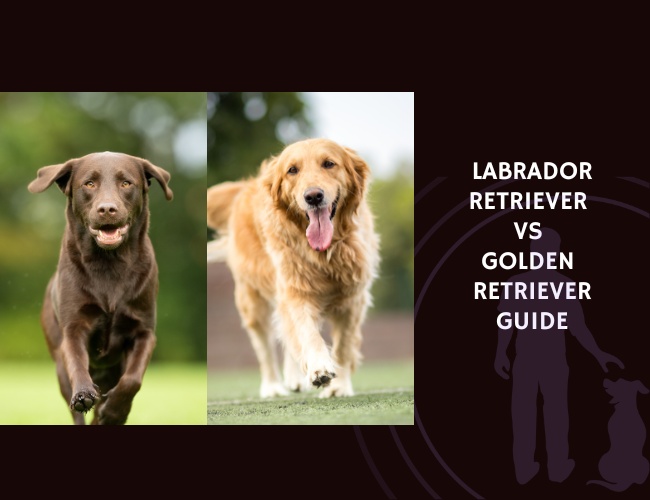Introduction to the Breeds
Popular family companions
Labrador Retrievers and Golden Retrievers are among the world’s favorite family dogs. Known for their friendly personalities and intelligence, both breeds have long histories as beloved companions and helpers. From busy family households to supportive therapy roles, they often shine thanks to their affectionate nature and willingness to please. What makes them so widely adored? It’s their mix of energy, sociability, and adaptability that appeals to a range of lifestyles.
The value of understanding breed differences
Choosing a dog for your family is a big decision. While Labradors and Goldens share many traits, there are meaningful differences in their temperament, energy levels, grooming needs, and even health profiles. Understanding these differences is key for finding the best fit for your home. A mismatch between breed and lifestyle can lead to frustration, behavioral issues, or disappointment. Taking time to learn about each breed ensures happier pets and owners alike.
About our approach and research
This chapter introduces a side-by-side analysis of Labrador and Golden Retrievers based on research and current breed knowledge. It’s important to note that much of the available research focuses on Labrador Retrievers, which means information about Golden Retrievers is sometimes less detailed or direct. This may limit how balanced some comparisons can be, and it’s something every reader should keep in mind as they continue.
Learning what makes each breed special helps everyone—prospective owners, breeders, and animal lovers—make better choices and promote responsible ownership. Ready to discover what sets these two popular breeds apart? Let’s dive into their fascinating backgrounds and unique traits. 🦴
Breed Origins and Historical Development
Early History and Ancestry
Labrador Retrievers and Golden Retrievers both have deep roots in the broad family of retrieving dogs, but their stories began in different corners of the world. Labrador Retrievers originate from Newfoundland, Canada. Here, they were bred as capable waterfowl retrievers, helping local fishermen and hunters retrieve fish and birds from cold waters. Their natural love of water and strong swimming ability made them ideal companions for tasks that required both endurance and a gentle mouth 🦆.
Golden Retrievers, on the other hand, trace their origins to Scotland. Bred specifically for hunting game birds, Golden Retrievers were developed for their keen sense of smell, intelligence, and ability to work alongside humans in the rugged Scottish countryside. Their elegant build and thick, water-repellent coats were beneficial in the often chilly and damp climate of their homeland.
Selective Breeding and Genetic Lineages
Both breeds share a common retrieving ancestry, but over time, selective breeding led to distinctly different lineages. The process of choosing dogs for specific traits, like coat type, retrieving ability, and temperament, resulted in the clear differences seen today. For Labradors, breeders focused on compact strength and energy, while Golden Retrievers were refined for their grace and gentle disposition.
Research indicates these selective practices shaped each breed’s unique genetics, influencing not only their physical appearance but also some behavioral tendencies. Although modern Labs and Goldens are often celebrated for their friendly, outgoing natures, science shows that genetic divergence has given rise to subtle yet important differences, such as energy levels and problem-solving approaches.
As we explore these beloved pets further, understanding their backgrounds adds valuable context to their similarities and differences. This foundation sets the stage for appreciating what makes each breed unique.
Physical Characteristics and Appearance
Coat Colors and Textures
Labrador Retrievers and Golden Retrievers are easy to tell apart thanks to their coats. Labradors come in three classic colors: black, yellow, and chocolate. Their coat is short, straight, and dense, providing protection from water and the outdoors. Golden Retrievers, on the other hand, are famous for their shimmering, medium-length coats. You’ll find them in various shades of gold—from pale cream to deep, rich golden hues. Their fur is wavier and softer, which adds to their gentle, elegant look.
Build and Body Shape
The Labrador Retriever has a more compact and muscular build. This strong physique makes them excellent at physical tasks and able to power through activities with enthusiasm. In contrast, Golden Retrievers are often described as slightly longer and more graceful in their frame. Their overall silhouette is softer and more refined, contributing to their reputation for elegance. Despite these differences, both breeds are athletic and well-proportioned.
Size and Weight
Both breeds are similar in size. Adult males typically weigh between 29kg and 36kg, while adult females usually range from 25kg to 32kg. Their height at the shoulder averages 55cm to 62cm. However, individual dogs may fall outside these ranges, and slight differences are normal.
Features at a Glance
- Labradors: Short, weather-resistant coat; sturdy and powerful look
- Goldens: Medium, flowing coat in gold shades; elegant and refined
- Both: Friendly faces, expressive eyes, balanced size
Understanding these physical traits helps families picture how each breed will fit into their lives. Physical differences play a role in grooming and maintenance, which are key topics for responsible ownership. 🐾
Temperament and Behavioral Traits
Energetic vs. Gentle Natures
When it comes to personality, Labrador Retrievers and Golden Retrievers each shine in their own way. Labradors are famously energetic and playful. They love games, outdoor adventures, and anything that allows them to use their boundless energy. If your family enjoys active outings or you need a buddy for new activities, a Labrador’s enthusiasm can be a perfect match. On the other hand, Golden Retrievers tend to be a bit more gentle. They are well known for their affectionate and patient nature, often bonding deeply with everyone in the house.
Genetic Influences on Behavior
Behavior in both breeds isn’t just shaped by training or environment—genetics play a role too. Labradors often show greater excitability, making them quick to respond to action and eager to engage in play or work. Golden Retrievers, while playful, may display a more sensitive side, making them highly attuned to their owner’s mood and emotions. Studies suggest that traits like sensitivity and excitability are inherited, so these behavioral styles run deep even with similar upbringings.
Family Friendliness and Sociability
One thing that unites these breeds is their warm nature. Both Labradors and Goldens are famously friendly and social, which is why they’re so popular as family pets. They thrive on being part of the action, enjoy meeting new people, and usually get along well with children and other pets. Early socialization helps bring out the best in both, ensuring confident and approachable dogs who love spending time with their humans.
Understanding these temperament differences helps families find the right fit for their lifestyle and sets the stage for exploring the unique strengths of each breed.

Trainability and Working Roles
Intelligence and Willingness to Please
Both Labrador Retrievers and Golden Retrievers stand out for their smarts and eagerness to please their humans. This combination makes them some of the easiest breeds for families and trainers to work with. They are quick learners who love positive feedback—whether that’s treats, petting, or praise. When these retrievers are given clear directions and plenty of encouragement, they thrive in structured settings and quickly master new tasks.
Common Specialties and Working Roles
Labrador Retrievers are particularly well-known for their work as guide dogs, detection dogs, and service animals. Their driven personality, high energy, and keen sense of smell make them exceptional at jobs like assisting people with vision impairments, detecting scents for police and security roles, and supporting people with disabilities. Labradors consistently top the lists in these professions because they balance enthusiasm with a strong work ethic.
Golden Retrievers, with their gentle manners and deep emotional connection to people, are stars in therapy work. Hospitals, nursing homes, and schools often choose Goldens for pet therapy programs. Their ability to “read the room” and comfort people makes them wonderful in jobs where emotional support is important. Golden Retrievers also do well as service and assistance dogs, especially in roles where calmness and sensitivity are needed.
Individuality in Abilities
While both breeds share great trainability, it’s important to remember that every dog is an individual. Genetics, early socialization, and environment all play a part in shaping how quickly a retriever picks up skills and how they respond to training situations.
As we explore more about these two breeds, understanding their trainability gives insight into their potential as beloved companions and working dogs.
Health Profiles and Common Medical Concerns
Genetic Predispositions and Joint Issues
Both Labrador Retrievers and Golden Retrievers are beloved for their friendly personalities, but they share some serious health concerns. One of the most well-known is hip dysplasia, a condition where the hip joint doesn’t develop properly. This can lead to pain and arthritis as dogs get older. Research strongly highlights genetic risk, especially in Labrador Retrievers, but Golden Retrievers are also at risk. Owners should be aware that both breeds need regular vet check-ups and should come from reputable breeders who screen for hip problems.
Another common joint issue is elbow dysplasia, a disorder causing pain and lameness. Both breeds can develop this, though detailed statistics skew more toward Labrador Retrievers. Taking steps such as maintaining a healthy weight and using joint supplements (as advised by a vet) can make a big difference.
Cancer and Eye Conditions
Cancer is another major concern for both breeds. Labradors and Goldens are prone to certain types of cancer, though variations in the most common types may exist between them. Lymphoma, for example, is well-documented in Labradors. For Golden Retrievers, cancers like hemangiosarcoma are of note. Sadly, the incidence of cancer in both breeds is higher than in some other dogs.
Eye health is also important. Progressive retinal atrophy (PRA) can affect both breeds, leading to gradual vision loss. Early detection and responsible breeding can help slow down these eye disorders.
Immune-Mediated and Other Health Issues
Both breeds can face immune-mediated diseases, meaning the immune system attacks the dog’s own cells. Other concerns include allergies and skin conditions, each breed having its own sensitivities. Managing these health risks involves regular vet visits, keeping up with vaccinations, and addressing symptoms early.
Overall, understanding these common health issues helps families provide better care for their four-legged friends. 🐶
One Bond, Two Paths.
Playful Power vs. Golden Grace.
Labradors burst with unfiltered energy—a splash-loving, task-driven buddy who thrives on action. Goldens bring softness to the same devotion, responding with calm affection and quiet intuition. Both adore you, but they show it in different tones.
Same Heart. Different Rhythm.
Whether you crave the wild joy of a Labrador’s leap or the steady warmth of a Golden’s gaze, each dog echoes a different kind of loyalty. Labs will push your pace. Goldens will ground your soul. One sprints with you. The other settles beside you.



It’s not about which is better. It’s about who fits you.
Choose the rhythm that matches your life. Choose the love that reflects your energy. Choose the Retriever that speaks your heart’s language.
Next, let’s explore how diet and nutrition can support the well-being of these wonderful breeds.
Nutritional Requirements and Weight Management
Age-related dietary differences
Labrador Retrievers Nutrition and Golden Retrievers Nutrition have similar basic dietary needs, but Labradors stand out for their changing amino acid requirements as they age. As Labradors grow from puppies to adults and seniors, it’s especially important to adjust their protein sources and amino acid balance for healthy joints and muscle maintenance. Golden Retrievers benefit from age-appropriate diets, too, but current research offers more detailed data for Labradors in this area.
Obesity risks and food motivation
Both breeds love food, but Labradors can be more food-motivated. This may make them slightly more prone to begging or overeating if owners are not careful. Obesity is a significant health risk in both Labradors and Goldens, leading to joint pain and heart issues. Portion control, careful selection of treats, and monitoring body condition help keep both breeds at a healthy weight. Some studies suggest that Labradors’ coat color and metabolic rate may also influence their risk of gaining weight, but more research is needed to confirm these factors.
Managing sensitivities and intolerances
Food allergies or sensitivities can appear in both Labradors and Goldens. Sometimes, individual dogs might react poorly to common proteins or grains. If you notice itching, digestive issues, or dull coats, speak to your vet about dietary adjustments. There is no clear breed difference in the types of allergies, but careful observation and specialized diets can make a big difference for sensitive pups.
Regular exercise is essential for both breeds, supporting not just weight management but also joint and mental health. Creating a feeding and exercise routine tailored to each individual dog ensures they stay happy and healthy, setting the stage for a great family life. 🦴
Lifestyle Compatibility and Exercise Needs
Energy levels and exercise routines
Labrador Retrievers are known for their high energy and strong need for vigorous daily exercise. Many Labs thrive when given jobs to do, enjoying activities like playing fetch, swimming, and agility courses. They require both physical activity and mental challenges to remain content. Without enough stimulation, Labradors can become bored and may develop unwanted behaviors. Golden Retrievers also enjoy physical activity but are generally a bit calmer. They often appreciate regular walks or play sessions but might not demand quite as much intensity as their Labrador cousins. Both need daily engagement, but the type and intensity may differ, with Labradors needing a little more zest in their routines.
Fitting in with families and other pets
Both breeds are recognized for their friendly nature and adaptability to various family environments. Whether you have younger children, teens, or other pets, Labradors and Goldens usually set a welcoming and playful tone. Early socialization is important for both to help them grow into confident and well-mannered adults. Their patience and gentle nature make them excellent choices for active households, and their sociability often extends to other dogs or even cats.
Urban and rural adaptability
Living in a city apartment or a countryside home, these breeds can adapt well given the right care. Labs, with their high energy, might appreciate spacious yards but can still be happy in urban settings if their exercise needs are met. Goldens, being a bit more relaxed, may find it easier to adjust to smaller living spaces, but still need daily opportunities to stretch their legs and play. The key is to tailor activities so your pup feels stimulated and loved, no matter your location.
Next, let’s shift our focus to personal care and everyday maintenance for these lovable companions.

Grooming and Maintenance Requirements
Shedding, Coat Care, and Brushing
Golden Retrievers are famous for their long, flowing coats—and with that beauty comes heavier shedding. If you bring a Golden into your home, expect to find golden tufts around the house, especially during peak shedding seasons. Labradors shed too, but usually not as much as Goldens. Their shorter, denser coats drop hair year-round, but often at a more moderate rate.
Both breeds need regular brushing to keep their coats healthy and minimize loose hair. For Golden Retrievers, brushing several times a week can help prevent mats and tangles. Labradors often do well with weekly brushing, though more frequent care never hurts, especially in spring and fall.
Preventing Matting and Skin Issues
Without regular grooming, both breeds risk developing mats, which can lead to skin discomfort and infections. Goldens, in particular, are more prone to matting due to their thick undercoat and feathered fur. Taking a few minutes to check for tangles after walks—especially behind the ears and along the belly—can prevent bigger problems down the line. Labradors have an easier time thanks to their sleeker coats, but dirt and debris can still get trapped, so routine checks help keep them comfortable.
Ear Care and Common Infections
Both breeds are prone to ear problems. Their floppy ears create a warm, moist environment where bacteria and yeast can flourish. It’s important to check their ears weekly and clean them with a vet-approved solution if you see redness or smell anything “off.” This can help you dodge painful infections and costly vet visits.
Regular grooming isn’t just about keeping these lovable retrievers looking sharp—it’s also key to their health and happiness. Consistent routines for coat and ear care will save you headaches and keep your pup smiling.
Emotional Intelligence and Social Needs
High Emotional Intelligence and Social Interaction
Labrador Retrievers and Golden Retrievers shine when it comes to emotional intelligence. These dogs form strong bonds with their families and are quick to pick up on human moods. Because of this, they are sought after as family companions and working dogs in roles like therapy or assistance. Both breeds enjoy being close to people, thriving on praise, affection, and group activities. Simply put, they want to be near you—whether you’re playing fetch, going for walks, or just relaxing at home.
Separation Anxiety and Emotional Resilience
While both breeds love social interaction, they can be prone to separation anxiety if left alone for long periods. Signs may include barking, chewing, or pacing when you’re away. Factors that influence emotional resilience include early socialization, positive experiences, and each dog’s unique temperament. Labradors and Goldens may express distress differently, but both benefit from routines, plenty of exercise, and mental enrichment. Creating a stable environment is key for their emotional well-being.
Hormones and Attachment Behaviors
Researchers have explored how hormones influence these breeds’ strong attachment to people. For example, studies in Labrador Retrievers highlight the role of oxytocin—the so-called “bonding hormone”—and cortisol, which is linked to stress, in shaping attachment behaviors. While less comparative data exists for Golden Retrievers, it’s believed that both breeds experience similar hormonal influences, contributing to their devoted natures and trust in their families.
These emotional needs help explain why Labradors and Goldens do best in families where they are included in daily life and given attention, helping them live their happiest, most balanced lives.
Ethical Breeding Considerations
Popularity and Overbreeding Risks
With their loving natures and good looks, both Labrador Retrievers and Golden Retrievers are among the most popular family pets worldwide. However, this popularity has a downside. High demand often leads to overbreeding, and sometimes breeders may focus more on quantity than on health or temperament. This can increase the risk of genetic issues, lead to abandoned pets, and raise questions about animal welfare. If you are thinking of bringing one home, it is important to learn about a breeder’s ethics and the dog’s lineage to avoid supporting questionable practices.
Impact of Show Lines vs. Working Lines
There are different lines within both breeds: show lines and working lines. Show lines often prioritize appearance, while working lines are bred for skills or tasks. This distinction can affect not just how the dogs look, but also their health and temperament. Dogs bred primarily for looks may be more prone to certain health issues, while those from working backgrounds could have higher energy needs or stronger instincts. Responsible breeders work to balance these factors, aiming for healthy, well-adjusted dogs that suit a variety of families.
Responsible Ownership and Welfare
Owning one of these beautiful breeds brings responsibility. Responsible ownership means more than providing food and shelter; it involves prioritizing regular veterinary care, proper training, and meeting your dog’s physical and emotional needs. Supporting breeders who do health checks and follow best practices helps protect the integrity of both breeds and keeps future generations healthy and happy.
Our commitment to informed choices ensures welfare for pets and peace of mind for families. 🐶
Making the Right Choice for Your Family
Matching the right dog to your lifestyle
Choosing between a Labrador Retriever and a Golden Retriever means thinking about your daily life, energy level, and long-term expectations. Labradors often have higher energy needs, loving vigorous play and outdoor activities. If your family enjoys hiking, running, or frequent park visits, a Labrador might be an ideal companion. Golden Retrievers also need regular exercise, but they may be more content with gentler walks and playtime. Both breeds fit well in active homes, but Labradors require more physical and mental stimulation to stay happy.
Considering first-time dog ownership
If you are a first-time dog owner, it can be tempting to decide based on looks or popularity. Both breeds are friendly and outgoing, but their personality differences can affect training. Labradors can be exuberant and may test boundaries, while Goldens are known for their gentle and patient nature, which can be reassuring for new owners. Early training, socialization, and clear routines set both breeds up for success in any home.
See the individual dog, not just the breed
While understanding breed traits is helpful, every dog is unique. Families should meet several dogs, talk to responsible breeders or shelters, and think about their specific needs and routines before committing. A Labrador may be quieter, or a Golden may be more energetic—individual differences matter just as much as breed averages. 🐶
Spending time with different dogs ensures you find a loyal friend who fits perfectly into your home and heart.
Conclusion: Similarities and Key Differences
Major Similarities
Labrador Retrievers and Golden Retrievers are beloved for good reason! Both breeds share a reputation for being friendly, trustworthy, and adaptable, making them excellent choices for families and active individuals alike. They are highly intelligent, eager to please, and versatile—traits that make them strong performers as working dogs, whether in guide and service roles or as therapy companions. Their affectionate and people-oriented nature means both Labradors and Goldens thrive on social interaction and plenty of playtime.
Their loyalty also extends to health and care requirements. Each breed is prone to similar health concerns like hip dysplasia and certain cancers, so responsible breeding and regular checkups are a must. Both breeds also bond deeply with their humans, meaning they need support and companionship for emotional well-being.
Subtle but Important Differences
Even with many similarities, there are key differences that might help you choose the right companion. Labradors often have a higher energy level and can be more exuberant, requiring plenty of mental and physical stimulation every day. In contrast, Goldens tend to be more gentle and sensitive, making them a bit easier for calm households or first-time owners. When it comes to appearance, Labradors are compact and powerful with three coat colors, while Goldens have elegant frames and their signature golden shades.
Grooming is another big difference. Goldens shed more heavily and need more frequent brushing, while Labradors’ shorter coats are lower maintenance but still benefit from regular care.
The Need for Further Research
Researchers have focused more on Labradors in genetics, nutrition, and health studies, leaving some gaps in comparative data with Goldens. For a clearer understanding and better healthcare for both breeds, ongoing research and balanced studies are essential.
Choosing between these two wonderful breeds often comes down to your lifestyle, preferences, and willingness to meet individual needs. Meeting different dogs and learning what fits best for your household will help ensure a loving home for years to come. 🐶










